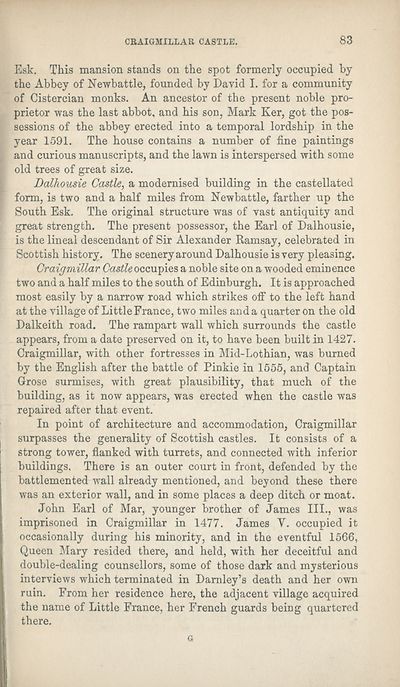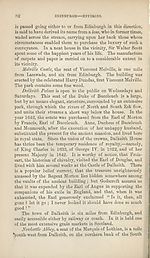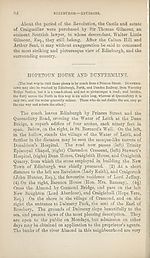Download files
Complete book:
Individual page:
Thumbnail gallery: Grid view | List view

CRAIGMILLAR CASTLE.
Esk. This mansion stands on the spot formerly occupied by
the Abbey of Newbattle, founded by David I. for a community
of Cistercian monks. An ancestor of the present noble pro¬
prietor was the last abbot, and his son, Mark Ker, got the pos¬
sessions of the abbey erected into a temporal lordship in the
year 1591. The house contains a number of fine paintings
and curious manuscripts, and the lawn is interspersed with some
old trees of great size.
Balhousie Castle, a modernised building in the castellated
form, is two and a half miles from Newbattle, farther up the
South Esk. The original structure was of vast antiquity and
great strength. The present possessor, the Earl of Dalhousie,
is the lineal descendant of Sir Alexander Ramsay, celebrated in
Scottish history. The scenery around Dalhousie is very pleasing.
Craigmillar Castle occupies a noble site on a wooded eminence
two and a half miles to the south of Edinburgh. It is approached
most easily by a narrow road which strikes off to the left hand
at the village of Little France, two miles and a quarter on the old
Dalkeith road. The rampart wall which surrounds the castle
appears, from a date preserved on it, to have been built in 1427.
Craigmillar, with other fortresses in Mid-Lothian, was burned
by the English after the battle of Pinkie in 1555, and Captain
Grose surmises, with great plausibility, that much of the
building, as it now appears, was erected when the castle was
repaired after that event.
In point of architecture and accommodation, Craigmillar
surpasses the generality of Scottish castles. It consists of a
strong tower, flanked with turrets, and connected with inferior
buildings. There is an outer court in front, defended by the
battlemented wall already mentioned, and beyond these there
was an exterior wall, and in some places a deep ditch or moat.
John Earl of Mar, younger brother of James III., was
imprisoned in Craigmillar in 1477. James Y. occupied it
occasionally during his minority, and in the eventful 1566,
Queen Mary resided there, and held, with her deceitful and
double-dealing counsellors, some of those dark and mysterious
interviews which terminated in Darnley’s death and her own
ruin. From her residence here, the adjacent village acquired
the name of Little France, her French guards being quartered
there.
Esk. This mansion stands on the spot formerly occupied by
the Abbey of Newbattle, founded by David I. for a community
of Cistercian monks. An ancestor of the present noble pro¬
prietor was the last abbot, and his son, Mark Ker, got the pos¬
sessions of the abbey erected into a temporal lordship in the
year 1591. The house contains a number of fine paintings
and curious manuscripts, and the lawn is interspersed with some
old trees of great size.
Balhousie Castle, a modernised building in the castellated
form, is two and a half miles from Newbattle, farther up the
South Esk. The original structure was of vast antiquity and
great strength. The present possessor, the Earl of Dalhousie,
is the lineal descendant of Sir Alexander Ramsay, celebrated in
Scottish history. The scenery around Dalhousie is very pleasing.
Craigmillar Castle occupies a noble site on a wooded eminence
two and a half miles to the south of Edinburgh. It is approached
most easily by a narrow road which strikes off to the left hand
at the village of Little France, two miles and a quarter on the old
Dalkeith road. The rampart wall which surrounds the castle
appears, from a date preserved on it, to have been built in 1427.
Craigmillar, with other fortresses in Mid-Lothian, was burned
by the English after the battle of Pinkie in 1555, and Captain
Grose surmises, with great plausibility, that much of the
building, as it now appears, was erected when the castle was
repaired after that event.
In point of architecture and accommodation, Craigmillar
surpasses the generality of Scottish castles. It consists of a
strong tower, flanked with turrets, and connected with inferior
buildings. There is an outer court in front, defended by the
battlemented wall already mentioned, and beyond these there
was an exterior wall, and in some places a deep ditch or moat.
John Earl of Mar, younger brother of James III., was
imprisoned in Craigmillar in 1477. James Y. occupied it
occasionally during his minority, and in the eventful 1566,
Queen Mary resided there, and held, with her deceitful and
double-dealing counsellors, some of those dark and mysterious
interviews which terminated in Darnley’s death and her own
ruin. From her residence here, the adjacent village acquired
the name of Little France, her French guards being quartered
there.
Set display mode to:
![]() Universal Viewer |
Universal Viewer | ![]() Mirador |
Large image | Transcription
Mirador |
Large image | Transcription
| Antiquarian books of Scotland > Scotland/Scots > Black's picturesque tourist of Scotland > (139) |
|---|
| Permanent URL | https://digital.nls.uk/130029858 |
|---|
| Description | Thousands of printed books from the Antiquarian Books of Scotland collection which dates from 1641 to the 1980s. The collection consists of 14,800 books which were published in Scotland or have a Scottish connection, e.g. through the author, printer or owner. Subjects covered include sport, education, diseases, adventure, occupations, Jacobites, politics and religion. Among the 29 languages represented are English, Gaelic, Italian, French, Russian and Swedish. |
|---|

